Community leaders from the Rust Belt Fibershed, Fibershed DACH, and Fibershed Ireland share their place-based experiences building a regional fiber system.
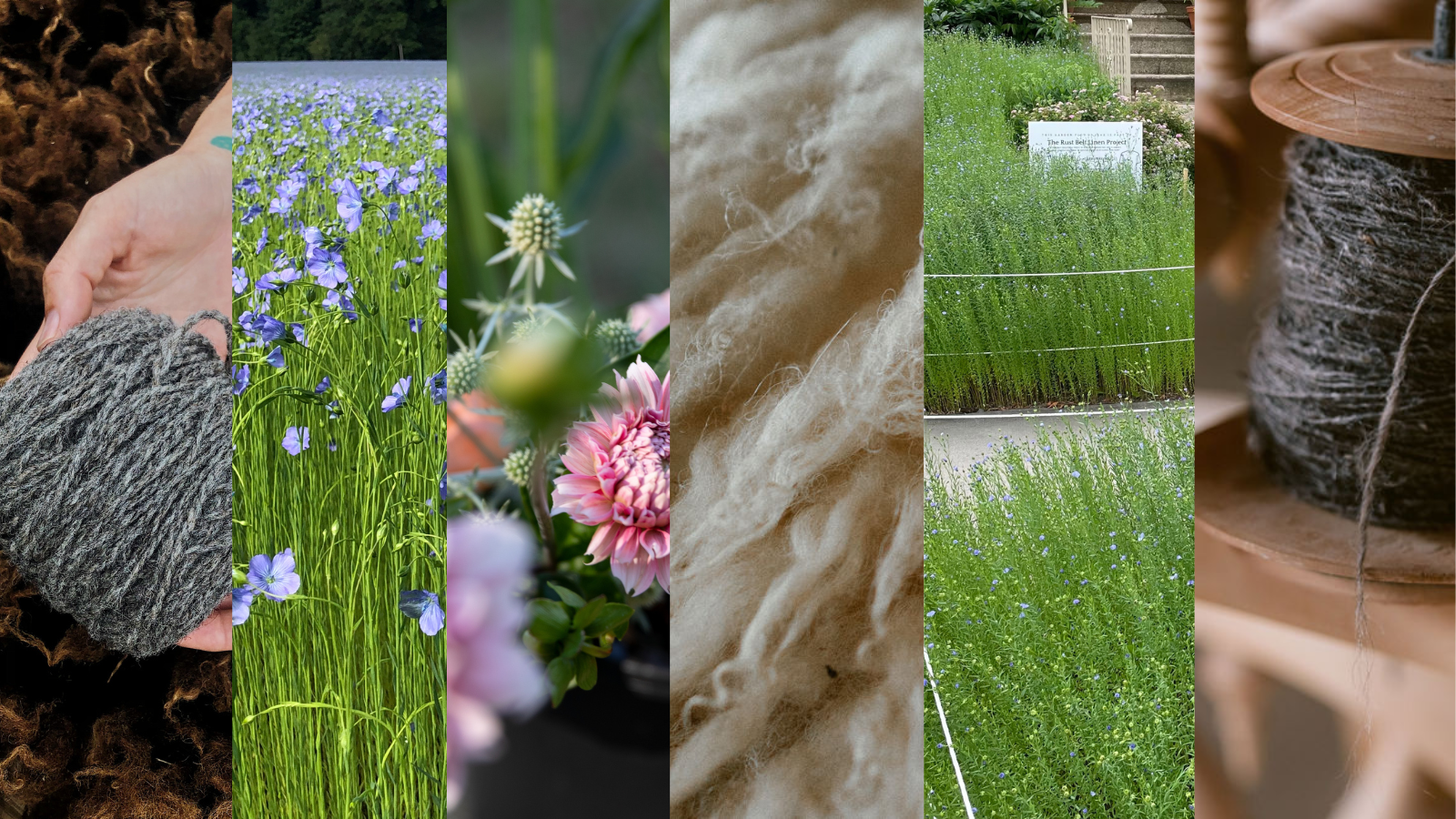
Fibershed is a noun, not just the name of an organization. A fibershed is a strategic geography that gives definition to a textile culture. It is where natural fibers and dyes are grown and communities exchange knowledge and expertise. The network of Fibershed Affiliates that now span the globe are living, working and continuously defining the capacity of these strategic geographies.
There are 58 and growing Fibershed Affiliates around the world, actively working in their home communities at every level of the soil-to-soil textile model. We work as an international community through the practice of tending, farming, ranching, spinning, weaving, dyeing, knitting, felting, wearing, caring, mending, composting, and so on. Each step of the process of making our second skin is done in unique and place-based ways, and we learn from each other. It’s uncanny how similar our triumphs and challenges are — which gives us hope that if we continue to collaborate and organize, we will find ways to continue to uplift and establish our soil-to-skin systems. Fibershed is honored to participate in this tapestry of placed-based leaders, all of whom have a unique and inspiring story to tell.
In the first edition of our Threading Resilience zine, we share 19 stories from our Fibershed Affiliates. We are rounding up three of their incredible stories in this article—from the Rust Belt Fibershed, Fibershed DACH, and Fibershed Ireland—to highlight the different geographies, journeys, and wisdom that can be shared from this network.
We hope you enjoy this round-up and all the wisdom it provides. Stay tuned for more stories from our affiliate communities in the coming months.
Enjoy these stories (told in their own words) from Fibershed Affiliates.
Rust Belt Fibershed: Building a Supply Chain, Flax-to-Linen
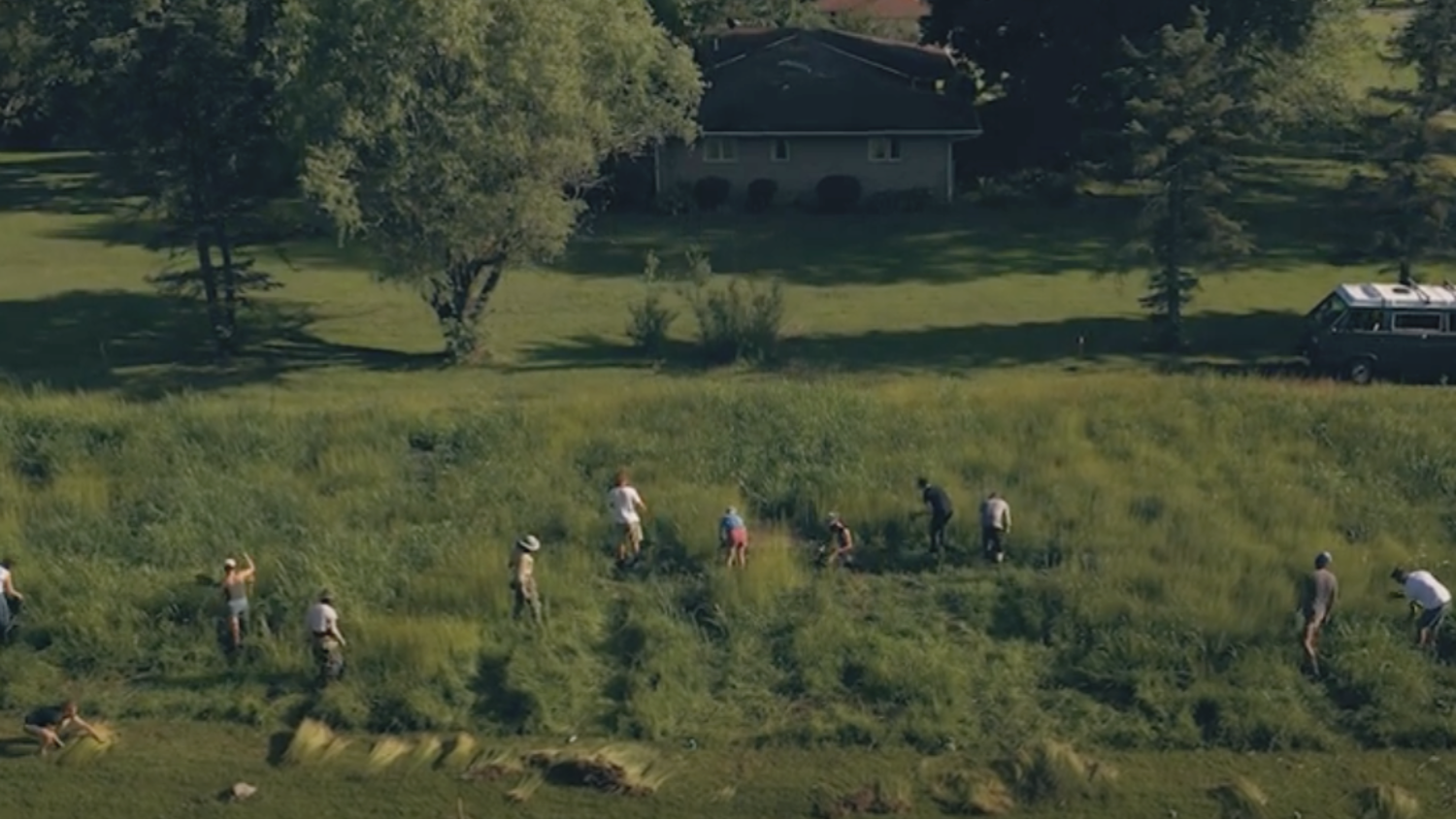
The Rust Belt Fibershed spans a radius of 250 miles outside of Cleveland, Ohio—including major cities such as Detroit, MI, Cincinnati, OH, Columbus, OH, Cleveland, OH, Pittsburgh, PA, and Buffalo, NY. We are a part of two major watersheds—the Lake Erie Watershed and the Mississippi River Basin. The industrial history of our area is rife with extraction and pollution, but as much of our steel industry has gone overseas in recent decades, Rust Belt Fibershed wants to replace that degenerative industrial repudiation with a Regenerative Textile System. We believe that Rust Belt Linen could be a large part of that future, with the entire supply chain of flax-to-linen, from soil-to-skin, housed within this fibershed.
2019: The Rust Belt Fibershed grew an acre of the Natalie variety of flax at Frayed Knot Farm, a regenerative flower farm, in Newbury, OH. The intention was to learn the basics: how does flax grow? How do we process flax? What infrastructure is needed? A community of volunteers helped at four different events: composting, seeding, harvesting, and processing. Because of a micro-grant from Fibershed, we were able to capture the over-a-year-long process with a 5-minute documentary-style film, created by Thomas Sawyer, which can be found on our website.

2020: Our second year we used the leftover Natalie seed from 2019 and planted 1/10 of an acre at Frayed Knot Farm. We refined our growing process, took extensive notes, and donated a lot of the processed project to our One Year One Outfit participants in 2021.
2021: This was our first year of a decentralized community-grow program. The seed was divided among 15 different home garden plots of all sizes, in 10 different cities, all collectively growing over an acre of flax. The intention was to get conversations going in different pockets of our fibershed about where our clothing comes from. This was also a seed-saving educational project, where we held conversations on the politics and benefits of seed saving. Participants reserved 10% of their plots beyond the fiber harvest to collect the seed for the 2022 season.
2022: This is the second year of the decentralized community-grow program with the Linore seed. We utilized both saved seed from the 2021 harvest and newly purchased seed from Fibrevolution. We currently have 33 different plots, spanning every corner of our fibershed, with participants from four different states (Michigan, Ohio, Pennsylvania, and New York). We are collectively growing over two acres of flax for artisan, hand-scale linen production. As we continue to build community, to create awareness around the origin of our clothing, and to supply local makers with hand-processed flax fiber to showcase proof of concept, this year we are also working on blending trials with industrial spinning of flax tow and alpaca with America’s Natural Fiberworks. We have also included researchers from both Kent State University and University of Michigan to conduct seed trials for possible future crop rotation trials. Our volunteers are also tracking data points (planting dates, germination rates, irrigation, first flower dates, etc.) as well as physical soil samples and dried and processed flax samples to submit to Rust Belt Fibershed. These plots are public facing, with an informational sign and a QR code to encourage participation in the conversation, and include learning institutions such as community gardens, schools, libraries, historical museums, art museums, and college campuses. We will be creating garments and textiles with this linen to demonstrate not only the skill of our community, but also the possibility and viability for the future of Rust Belt Linen, as we hope to continue funding and expansion of this project in future seasons.
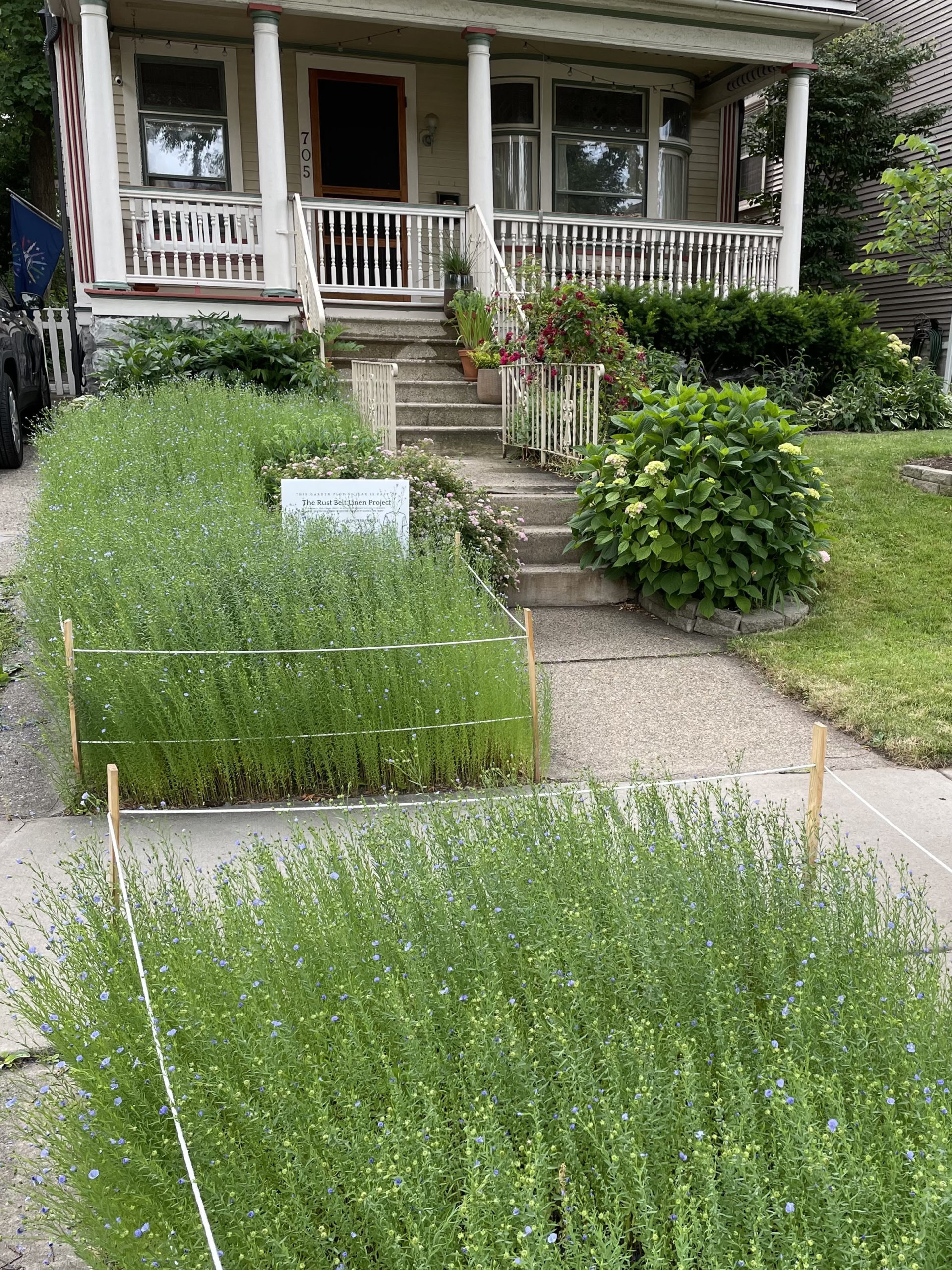
Currently, our hand-scale processing of flax is far too labor intensive and expensive to clothe our general population. In order to make linen accessible, we are looking for support to build the industry and employment capacity. Because there are currently no regional-scale flax processing facilities in the United States, we see this as a groundbreaking opportunity to take an incredible asset of our region and rewrite how the Rust Belt does industry, making textiles while supporting the whole production chain in collaborative workspaces and regenerative ecosystems.
Rust Belt Fibershed & Water
The Great Lakes are the world’s largest freshwater system, and The Rust Belt Fibershed is housed within four of the five Great Lakes’ watersheds. Water from our farms and cities within our bioregion flows into Lake Michigan, Lake Huron, Lake Erie, and Lake Ontario. The other half of the Rust Belt Fibershed feeds the Mississippi River drainage basin, the second largest river basin in the world. Because of the direct impact, our bioregion has on both fresh and saltwater ecology, we believe that we have a great responsibility to incorporate water preservation and restoration as we work with consumers, brands, and future textile industry innovators.
We are just getting started with this work and welcome all forms of collaboration that might help regenerate these exceptional aquatic ecosystems.
Learn more about the Rust Belt Fibershed
Geographic area: 250-mile radius from Cleveland, OH
Website: https://rustbeltfibershed.com/
Follow along at @rustbeltfibershed
Fibershed DACH
How a dozen dedicated women in Germany, Austria, and Switzerland have started to promote textile production from local fibres.

Our journey started in winter 2021. We founded Fibershed DACH — short for Germany, Austria and Switzerland — to promote the regional production of textiles and home goods from local fibres and to connect alpine farmers, big-city designers, traditional manufacturers and a new generation of craftspeople. On our website, we bring together land stewards, designers, producers and textile artists in an open source network — with free access for anyone interested in the fibershed idea.
We have formed material-specific groups for wool, bast fibers and leather, and are in touch with the most important stakeholders and research projects throughout Europe. We meet regularly in the digital space to exchange information and to plan future projects. What unites us is the common desire to change the textile industry for the better.

Timeless design and aesthetics are key for us because we want to be attractive for contemporary designers and art colleges. We would like to show that sustainable, local production and sophisticated design are not mutually exclusive. Therefore, we see the visual design of our website, of our other communication channels and of future products as a key factor to our success.
What our research has shown is that local supply chains may or may not work depending on the material. While local production is possible for leather, we are far from having a regional bast fiber production chain — despite the historical tradition. But even if the picture varies depending on the material, we sense a similar development for all plant and animal fibres: towards local, transparent production. Through our work in networking, education, and research, we hope to reach, educate and empower as many people as possible.
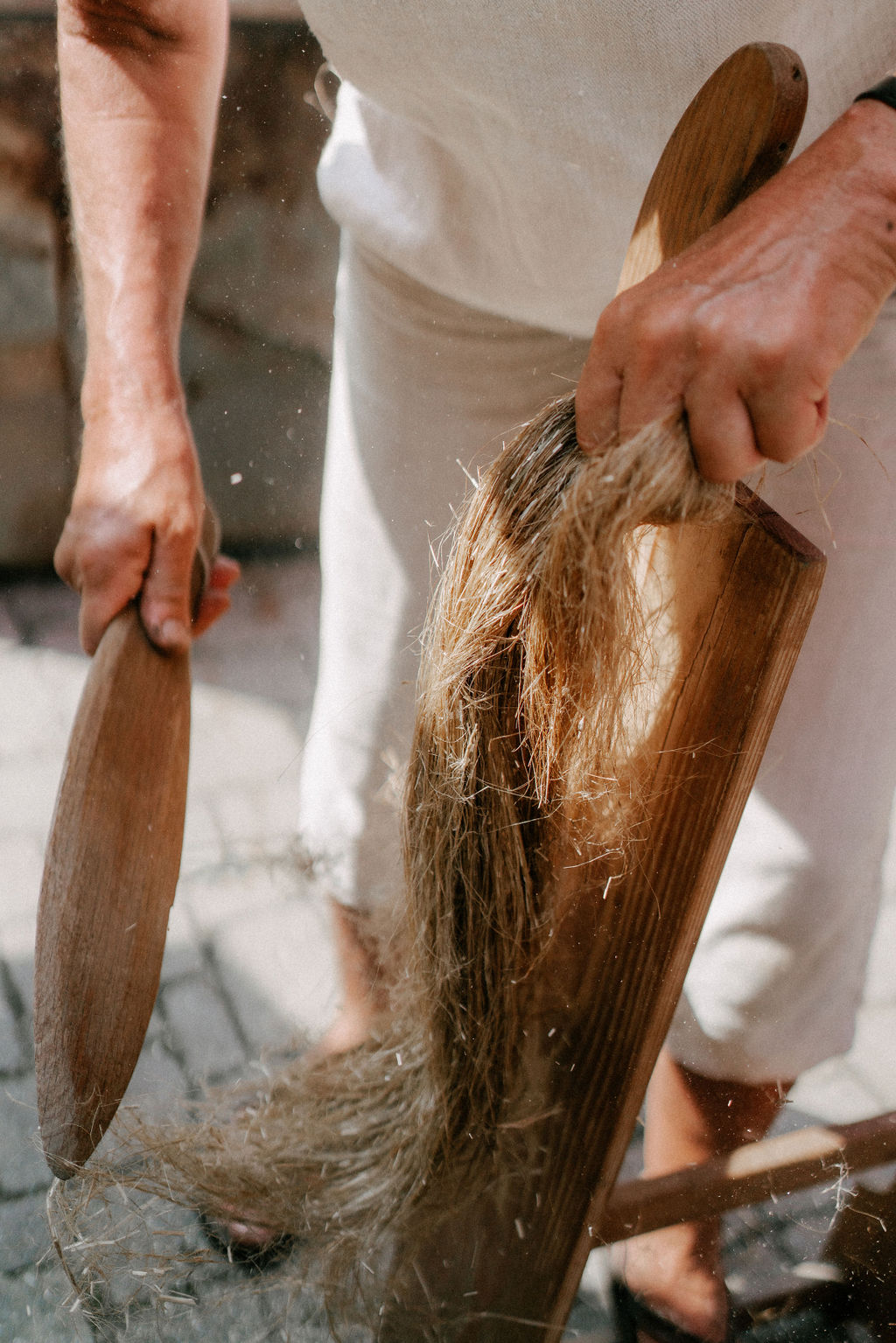
In the coming months, we plan to invest our time primarily in building our community and becoming more visible. Our team has a lot of knowledge and skills in various fields and is networked in the industry. We want to use this expertise to make it available to others and actively contribute to the sustainability dialogue in the textile industry. We are really looking forward to the journey ahead of us!
Learn more about Fibershed DACH
Geographic area: Germany, Switzerland, Austria
Website: www.fibershed-dach.org
Follow along at @fibershed.dach
Fibershed Ireland: Liadain Aiken Knitwear x Moy Hill Farm: A case study in the future of local Irish textiles
Written by Malú Colorín of Fibreshed Ireland

Although only a few months old, Fibreshed Ireland has been received with very open arms by the local fibre community, who for a very long time have struggled with a few of the common problems that most of the global Fibershed affiliates also face. Some of these issues include a fragmentation in the local fibre value chain, resulting in a lack of communication between farmers, spinners, weavers, dyers, designers and brands. A big concern in Ireland is that sheep farmers are not making any profit from their fleeces and, in fact, shearing actually tends to cost them money. On the other hand, Irish designers and crafters are avid to include more local materials in their creations, but struggle to find them.
At Fibreshed Ireland, we’re working to establish a supportive network to facilitate a regenerative fibre system based on local fibre, local dyes and local labour. A great case study for the kind of relationships and collaborations we want to help cultivate is the Liadain Aiken Knitwear & Moy Hill Farm ‘Farm to Yarn Collaboration’. Although this partnership sparked organically between the two parties involved, even before Fibreshed Ireland existed, we’ve had the pleasure of witnessing the process and supporting the second iteration of this beautiful local yarn co-creation.
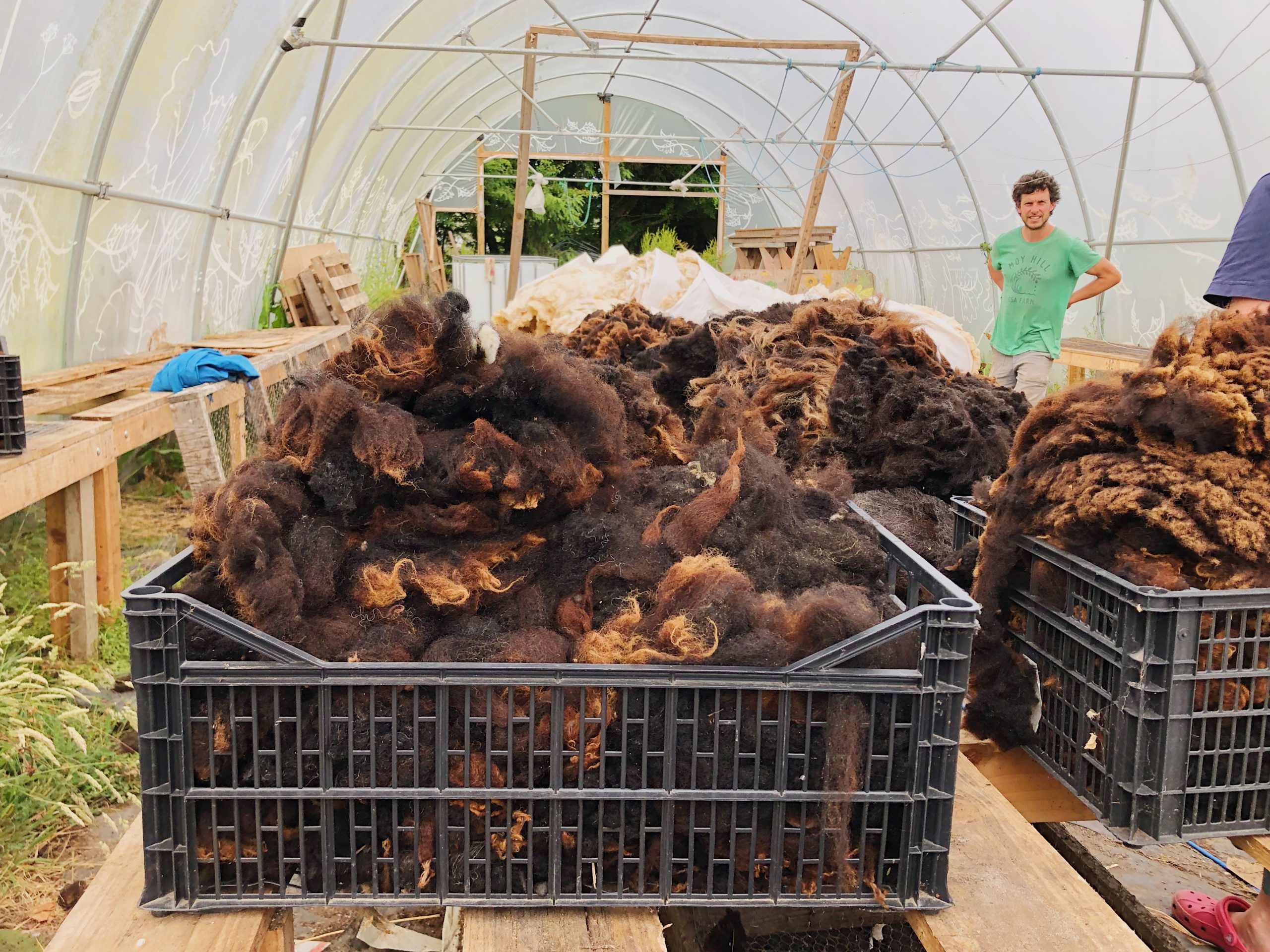
It all started in 2020, when Sally and Fergal Smith, who own and run Moy Hill Farm, contacted knitwear designer Liadain Aiken to ask if she was interested in using the fleeces of their Jacob sheep. They had recently acquired a small flock who were in desperate need of shearing, but had no idea about how to get the wool processed into yarn. The Smiths run Moy Hill Farm as a regenerative operation, growing vegetables that are mostly sold around their local community. Their herd of Jacob sheep and Dexter cows are grazed following the Savory Institute’s holistic model: they are rotated daily around various different small paddocks for access to the freshest and more nutrientdense pastures. “Holistic management involves a careful balance of planning, while also staying flexible and very observant of what the animals’ needs actually are. I love observing my cows and my sheep and learning from them every day”, says Fergal Smith. All with the added benefit of helping the soil quality improve.
It’s almost hard to imagine that only a few decades ago, the world-famous Irish Aran jumper was made from local fibre, yet today the scouring, carding and spinning of wool is such a mystery to the people who tend the sheep and our famous jumpers are made from merino imported from Australia or New Zealand. But things are starting to change and we’re slowly remembering, which makes it such an exciting time to be starting a Fibershed affiliate in Ireland.
Liadain was delighted to take on the challenge: for a while she had been dreaming of working with yarn spun from Irish animals, so this was perfect! Unfortunately turning the fleeces of the now shorn sheep into yarn was difficult and very slow to do in Ireland, so Liadain decided to invite yarn designer Diarmuid Commins to join the ship she now found herself at the helm of. Diarmuid, who for a very long time ran S Twist yarn, sorted, graded, scoured and dried the Moy Hill wool before sending it off to his partners in Portugal for spinning.

A few months later, the beautiful light brown-grey 2 ply Aran weight yarn was back from Portugal, ready for Liadain to start experimenting with. “It turned out to be much softer than I had expected it would be!”, told us Liadain the first time we met with her to talk about Fibreshed Ireland. “It probably won’t make for a next-to-skin garment, but it could be worn as outerwear, with a shirt underneath.” The first garment that she started swatching for and designing is a sleeveless jumper with a classic round neck for Fergal, the man whose sheep grew the fibre. He loves the idea of wearing something that was grown in his own farm and can’t wait for Liadain to finish hand-knitting the vest.
This year, the ‘Farm to Yarn Collaboration’ continues, with a few changes. Fergal’s flock has grown to 34 sheep, some of which are now a Jacob/Zwartbles mix. Unlike the first iteration, this time the wool was skirted and sorted by Liadain and Fergal themselves, with instructions, help and support from other members of our Fibreshed, including felt artist Christina Keawwantha, wool expert Sandra King, mill owner Jess Kavanagh and natural dyer Malú Colorín. Liadain is especially proud of the fact that this year’s yarn will actually be spun within our shores. Jess Kavanagh from Olann Mills has joined in this collaboration and will be scouring and spinning the Moy Hill wool in her mini mill in the early autumn.
We’re very excited to see how this project will evolve and flourish over the coming years and will be using this case study as a blueprint to base our own work as facilitators of collaboration and networking between the various stakeholders in our local fibre systems. Liadain Aiken is already a very involved member of our Fibreshed and there are many more designers who, like her, have a thirst to work with fibres that have been grown in this Land. The potential to bring together fibre farmers and designers in this island is huge, and with the right processing methods and facilities there is no doubt in our minds that the Irish textile ecosystem can once again bloom and flourish, helping improve soil health along the way.
Learn more about Fibershed Ireland
Geographic area: Ireland
Contact: fibreshed_ireland@gmail.com
Follow along at @fibreshed_ireland

